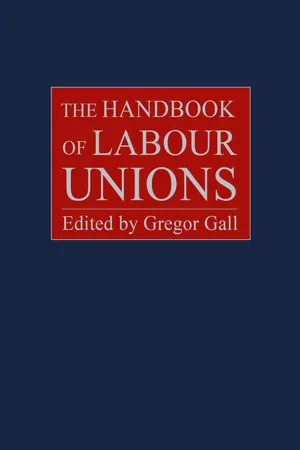
- English
- ePUB (mobile friendly)
- Available on iOS & Android
The Handbook of Labour Unions
About this book
Growing levels of income and wage inequality and the precaritization of many sections of the labour force have made labour unions as salient as ever. Although membership levels have decreased, they remain among the world's largest representative organizations and continue to play a significant role as vehicles for democracy, sustainable development and social justice.
This handbook assembles an array of experts to critically engage with the debates and discussions about the role and purpose of unions and the many means by which they seek to attain them. The book provides insights into how unions can meet the challenges of structural changes in the labour market, including technological progress, the green agenda and the digital platform economy, and how they can better represent the needs of their members, in particular migrant, domestic and informal workers.
The book is a valuable resource for industrial relations, labour economics, sociology of work, employment and labour law, history of trade unionism, working patterns and practices, workplace culture and workers' rights.
Frequently asked questions
- Essential is ideal for learners and professionals who enjoy exploring a wide range of subjects. Access the Essential Library with 800,000+ trusted titles and best-sellers across business, personal growth, and the humanities. Includes unlimited reading time and Standard Read Aloud voice.
- Complete: Perfect for advanced learners and researchers needing full, unrestricted access. Unlock 1.4M+ books across hundreds of subjects, including academic and specialized titles. The Complete Plan also includes advanced features like Premium Read Aloud and Research Assistant.
Please note we cannot support devices running on iOS 13 and Android 7 or earlier. Learn more about using the app.
Information
Table of contents
- Cover
- Half Title
- Title Page
- Dedication
- Contents
- Acknowledgements
- Contributors
- Introduction
- Part I – Components, characteristics and context
- Part II – Space, power and periodization
- Part III – The practice of building presence and power
- Conclusion
- Index